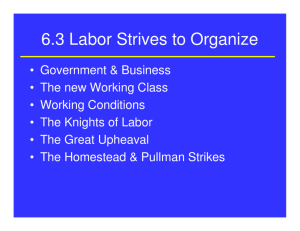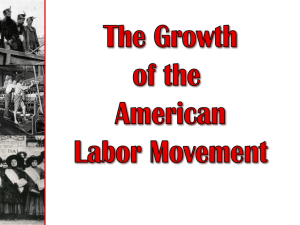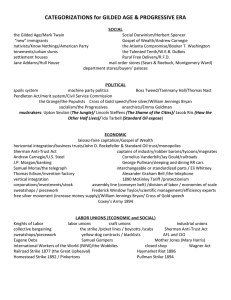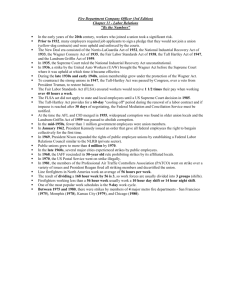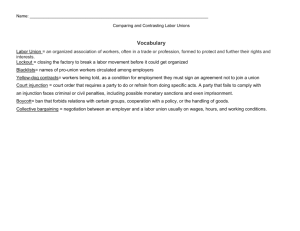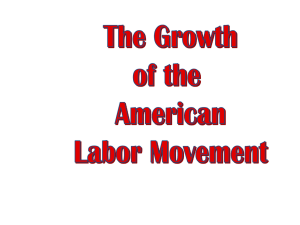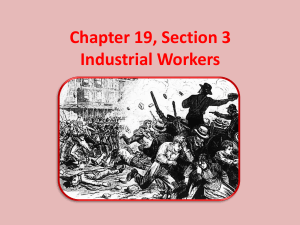Slide 1
advertisement
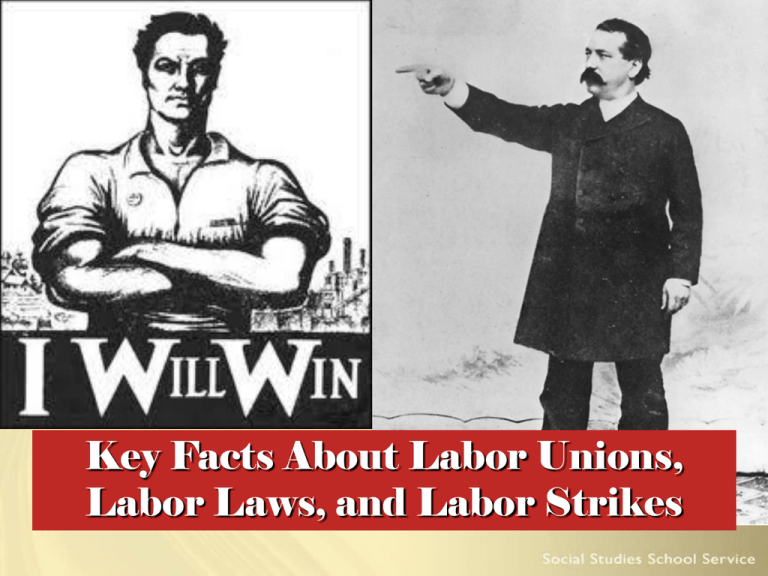
Key Facts About Labor Unions, Labor Laws, and Labor Strikes The Knights of Labor • Terence V. Powderly, 1886 • Grew rapidly because of a combination of open membership policy, the continuation of industrialization, and the growth of urban population • Knights welcomed unskilled and semiskilled workers, including women, immigrants, and African Americans • Had an ideal vision that they could eliminate conflict between labor and management – Believed labor should own industries • Haymarket Square Bombing signaled end of Knights influence The Industrial Workers of the World • IWW was led by “Mother” Jones, Big Bill Haywood, and Eugene Debs • Strove to unite all laborers, including unskilled workers • IWW’s motto was “an injury to one is an injury to all” – “One Big Union” • IWW endorsed violent tactics and class conflict (unlike Knights of Labor) • Never as big as Knights, collapsed during WWI The American Federation of Labor • Led by Samuel Gompers • An alliance of skilled workers in craft unions • Concentrated on bread and butter issues such as higher wages, shorter hours, and better working conditions – Most conservative of early labor unions – Did not support unions for women and African-Americans Great Railroad Strike, 1877 • Considered the first general strike in American history • Paralyzed the nation’s commerce for 45 days • Governors in 10 states forced to use state militia to reopen rail traffic Sherman Antitrust Act, 1890 • This act forbade unreasonable combinations or contracts in restraint of trade • Little immediate impact – Actually used against labor unions • Act declared illegal “every contract, combination in the form of trust, or otherwise, or conspiracy in restraint of trade among the several states” Homestead Strike, 1892 • Strike began as a dispute between iron and steel workers union (AA) and Carnegie Steel Company • AA refused to accept pay cuts and went on strike in Homestead, PA • Strike culminated in a battle between strikers and private security guards hired by the company (Pinkertons) Pullman Strike, 1894 • Late 19th century characterized by a number of violent strikes – Two best known were Homestead, 1892 and Pullman, 1894 • Pullman Palace Car Company cut wages but maintained rents and prices in a company town of 12,000, workers struck • Pullman Strike halted a substantial portion of American rail commerce • Strike ended when President Grover Cleveland ordered federal troops to Chicago (injunction) to crush the strike (protection of interstate commerce) Anthracite Coal Strike of 1902 • This was a strike by the United Mine Workers of America in the anthracite coal fields of eastern Pennsylvania • It was arbitrated with the active involvement of President Theodore Roosevelt; this marked the first time the federal government intervened in a labor dispute as a neutral arbitrator The Wagner Act of 1935 • AKA the National Labor Relations Act • Often referred to as the Magna Carta of Labor because it ensured workers’ right to organize and bargain collectively • Passage of the act led to a dramatic rise in labor union membership Congress of Industrial Workers • Led by John L. Lewis • Organized unskilled and semiskilled workers in basic manufacturing industries such as steel and automobiles • Split between AFL and CIO – AFL favored organization based on skills and trades – CIO favored organization of all workers in a particular industry Taft-Hartley Act, 1947 • Primary purpose was to curb the power of labor unions • Supporters of Taft-Hartley believed the following: – Unions were abusing their powers – Widespread strikes would endanger the nation’s vital defense industries – Some labor leaders had been infiltrated by communists – Employers were being coerced into hiring union workers • Organized labor opposed the Taft-Hartley Act • Passed over President Truman’s veto United Farm Workers • Organized and led by Cesar Chavez (Chavez is best-known Latino civil rights activist) • Union of farm workers • Tactics used by Chavez included hunger strikes • Most farmworkers were Mexican immigrants and Mexican-Americans
